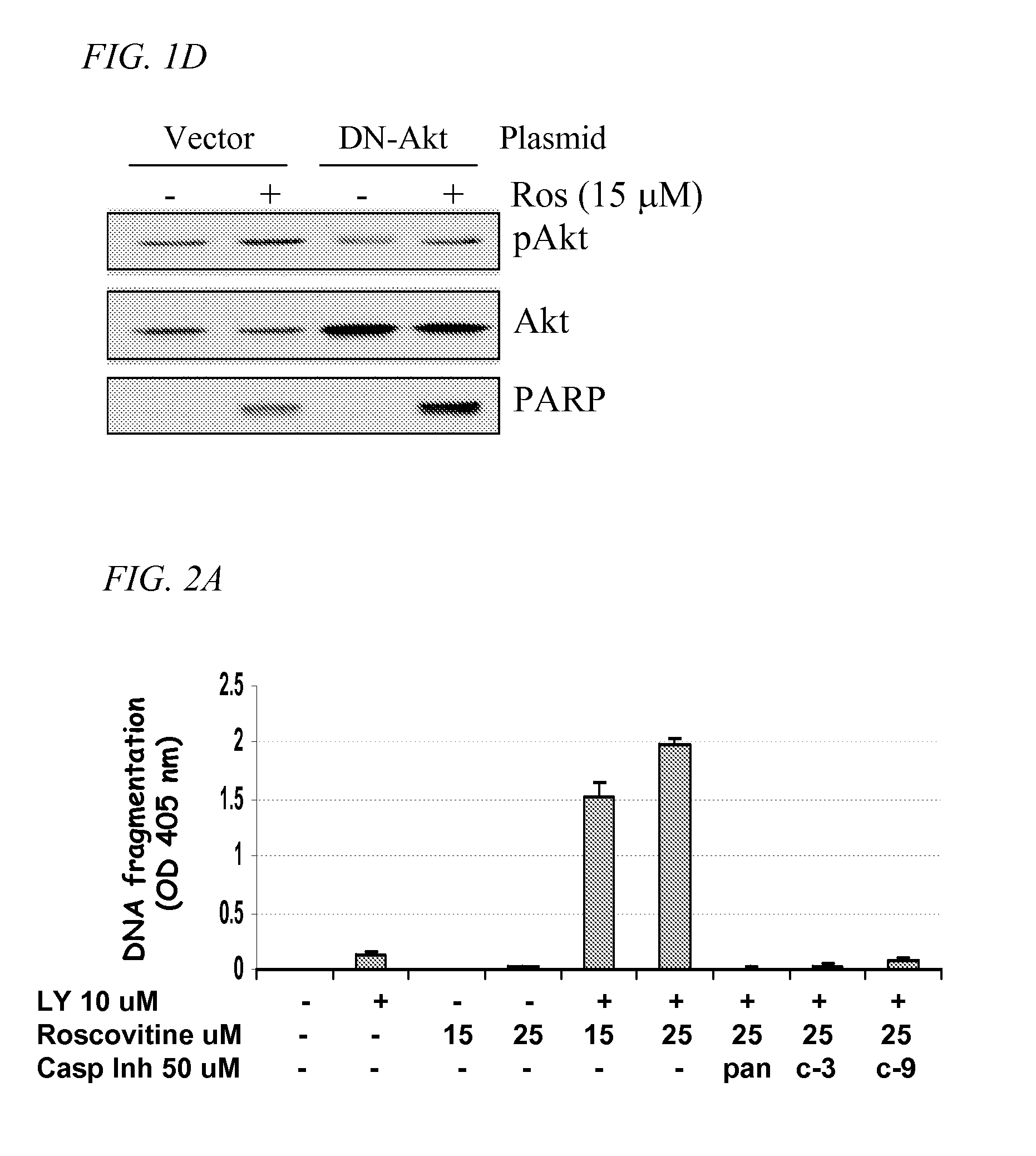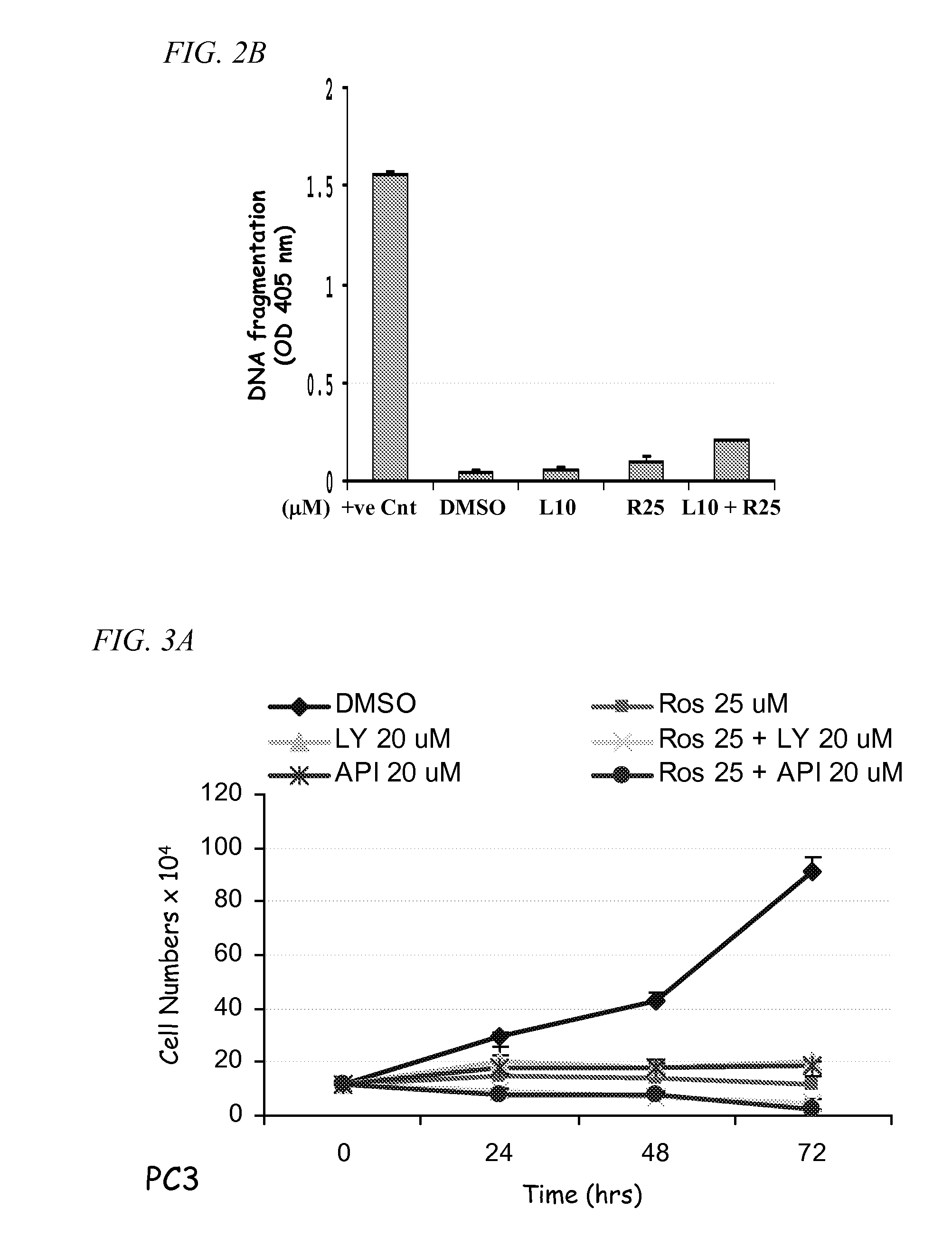PI3K-Akt Pathway Inhibitors
a technology of akt inhibitors and akts, which is applied in the field of cancer therapy, can solve the problems of ineffective life-prolonging therapy for aggressive, androgen independent prostate cancer, and achieve the effect of increasing the abundance of bim
- Summary
- Abstract
- Description
- Claims
- Application Information
AI Technical Summary
Benefits of technology
Problems solved by technology
Method used
Image
Examples
example 1
Roscovitine and AKT Inhibitors Induce Rapid Onset of Apoptosis of LNCaPs
[0098]We previously reported that roscovitine can induce apoptosis of LNCaP and LNCaP-Rf prostate cancer cells, but not PC3 cells that are p53 null [Mohapatra, S., et al., 2005]. Apoptosis required accumulation of p53 and down-regulation of XIAP.
[0099]In an effort to determine whether inhibitors of key signaling pathways, such as the protein kinase A, Janus kinase, protein kinase C, p38, PI3K or Map kinase pathway, can enhance roscovitine-induced apoptosis, we treated LNCaP cells with a combination of roscovitine and one of the pathway specific inhibitors for 8 hours and examined the cell lysates for apoptosis. Apoptosis was monitored by cleavage of the caspase-3 substrate poly (ADP-ribose) polymerase (PARP). Results show that the combination of roscovitine with wortmannin or LY, inhibitors of PI3K, induced significant PARP cleavage (FIGS. 1A-B). By themselves, roscovitine, wortmannin or LY did not induce any PA...
example 2
Roscovitine and AKT Inhibitors Cooperate to Induce PC3 Apoptosis
[0100]PC3 and PC3-MM2 cells received roscovitine, LY, API-2, rosc / LY or rosc / AP for 72 hr and alterations in cell growth were monitored. As shown in FIG. 3 A-B, LY, API, roscovitine or their combinations inhibit cell growth. However, inhibition of cell growth below the initial plating density was observed when cells were exposed to rosc / LY or rosc / API. Similar growth inhibition was also observed in PC3-T55 cells that were resistant to taxol (FIG. 3C). Further, effects of the combination treatment in altering colony formation potential were examined. For this purpose, cells were exposed to drugs for 24 or 46 hrs and trypsinized. Ten thousand viable cells were replated and allowed to grow colonies for 2 weeks. Results shown in FIG. 4 A-C suggest that significant inhibition in colony formation was detected only when cells were exposed to rosc / LY or rosc / API for longer than 24 hrs. It is to be noted that, even after 48 hr e...
example 3
Downstream Mediators of Apoptosis
[0102]XIAP and Bim. As anticipated, short-term exposure to roscovitine did not alter expression of Cdk2, Cdk7 or Cdk9. However, it reduced activity of Cdk7 / Cdk9 as measured by phosphorylation of RNA-Pol II. API-2 reduced AKT activity and increased Bim abundance (FIG. 6A). Longer exposure to roscovitine reduced expression of XIAP, but not Bcl-2 (FIG. 6B) [Mohapatra, S., et al., 2005]. Roscovitine did not alter Bim abundance in either the presence or absence of API-2; API-2 slightly reduced XIAP abundance in the absence of roscovitine but had no effect in the presence of roscovitine. These findings identify XIAP as a potential roscovitine target and Bim as a potential API-2 target in PC3 cells. We note that there are several isoforms of Bim, most notably BimS, BimL and BimEL. In LNCaP and PC3 cells, BimEL was the predominant form.
[0103]To assess the relevance of XIAP down-regulation, we depleted PC3 cells of XIAP by RNA interference. Cells were infecte...
PUM
| Property | Measurement | Unit |
|---|---|---|
| Level | aaaaa | aaaaa |
Abstract
Description
Claims
Application Information
 Login to View More
Login to View More - R&D
- Intellectual Property
- Life Sciences
- Materials
- Tech Scout
- Unparalleled Data Quality
- Higher Quality Content
- 60% Fewer Hallucinations
Browse by: Latest US Patents, China's latest patents, Technical Efficacy Thesaurus, Application Domain, Technology Topic, Popular Technical Reports.
© 2025 PatSnap. All rights reserved.Legal|Privacy policy|Modern Slavery Act Transparency Statement|Sitemap|About US| Contact US: help@patsnap.com



